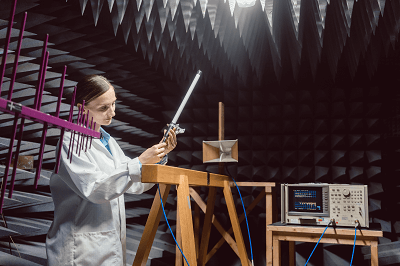What Is an EMC Test?

EMC test, or electromagnetic compatibility (EMC) test is an examination conducted to verify the performance of EMC.
EMC test consists of two components: the EMI (Electromagnetic Interference) test and the EMS (Electromagnetic Susceptibility) test. EMI test measures the electromagnetic waves emitted by electronic devices and similar equipment to the external environment. This test ensures that the levels of electromagnetic waves radiated into space from electronic devices comply with specified standards.
Specifically, the test measures electromagnetic waves emitted to the external environment through radiation or conduction from electromagnetic waves or power and communication harnesses. On the other hand, the EMS test evaluates the resistance of electronic devices to external electromagnetic waves.
In the EMS test, external noise such as static electricity and radiated electromagnetic fields is applied to electronic devices. The test verifies whether electronic devices operate normally even when subjected to noise within the specified standards.
Uses of EMC Test
EMC test is conducted to meet the standards set by EMC regulations and specific EMC standards for various countries and regions. During the pre-sale product development stage, the purpose is to perform EMC tests as defined by the standards and confirm compliance.
Once the standards are met, electronic devices can be sold in the market.
Principle of EMC Test
EMC test adheres to international standards established by the IEC (International Electrotechnical Commission) and its committee, CISPR (International Special Committee on Radio Interference). While IEC primarily focuses on EMS test standards, CISPR concentrates on EMI test standards.
EMC regulations in various countries and regions are based on IEC and CISPR standards. The United States and Europe have stringent regulations on EMC through legal measures. In Japan, there are no specific regulations regarding EMC, and industry organizations like VCCI have adopted voluntary regulatory measures.
Types of EMC Test
1. Radiated Emission Test
Quantifies electromagnetic waves radiated from electronic devices using an antenna and verifies if the measured values are within predetermined standards. The test is conducted in a radio wave darkroom or open site, measuring frequencies above 30MHz.
2. Conducted Emission Test
Quantifies electromagnetic waves conducted and radiated from the power or communication lines of electronic devices using a spectrum analyzer. The test is conducted in a radio wave darkroom or shield room, measuring frequencies from 9kHz to below 30MHz.
3. Electrostatic Discharge Immunity Test
The test checks if electronic devices operate normally when subjected to static electricity. The test is conducted by applying static electricity from an electrostatic discharge gun to electronic devices.
There are direct discharge tests where static electricity is applied directly to electronic devices and indirect discharge tests where static electricity is applied from conductive objects near electronic devices.
4. Radiated Electromagnetic Field Immunity Test
This test verifies if electronic devices operate normally when exposed to high-frequency electromagnetic waves. The test is conducted in a radio wave darkroom or open site, using a test antenna to apply frequencies above 80MHz to electronic devices.
5. Electrical Fast Transient/Burst Immunity Test
This test checks if electronic devices operate normally when transient abnormal voltages occur during the interruption of coils or inductors. The noise is applied to the power or communication lines of electronic devices.
For the power line, noise is applied to the electronic device’s inlet. For the communication line, the electronic device’s communication harness is clamped using a coupling device, and noise is applied to the communication line.
6. Surge Immunity Test
This test checks if electronic devices operate normally when transient abnormal voltages occur during lightning strikes or ON/OFF switching of switches. The noise has a longer cycle than transient bursts. A dedicated test apparatus is used to apply noise to the power or communication lines of electronic devices.